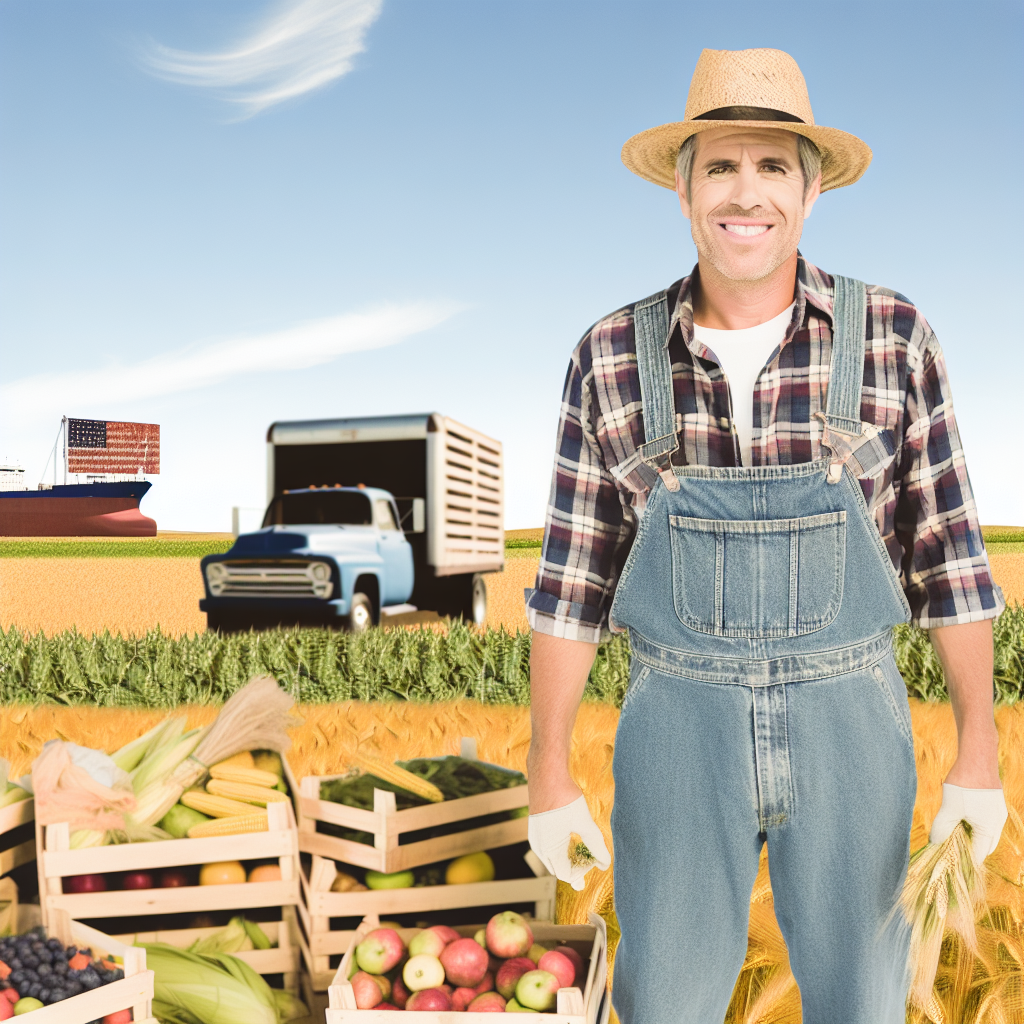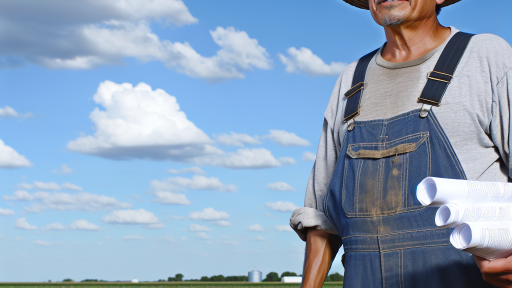Introduction to Tariffs and Their Historical Context in Agriculture
Tariffs have played a significant role in shaping agricultural trade throughout history.
They serve as a tax imposed on imported goods.
This tax can influence market prices and trade volumes.
Historical Overview of Tariffs in Agriculture
The use of tariffs dates back centuries, with various countries implementing them.
Early tariffs aimed to protect domestic industries from foreign competition.
For instance, in the United States, tariffs were used extensively during the 19th century.
These tariffs enabled local farmers to compete against cheaper imports.
Impact of Tariffs on Agricultural Exports
Currently, tariffs can significantly impact agricultural exports.
They may create barriers for farmers looking to enter foreign markets.
A high tariff rate can decrease demand for domestically produced goods abroad.
Consequently, farmers experience reduced income and disrupted supply chains.
Recent Developments in Tariff Policies
In recent years, trade disputes have led to changes in tariff policies.
Notably, the U.S.-China trade war raised tariffs on several agricultural products.
This scenario has challenged American farmers, particularly in the soybean industry.
Farmers reported substantial income losses due to decreased exports to China.
Transform Your Agribusiness
Unlock your farm's potential with expert advice tailored to your needs. Get actionable steps that drive real results.
Get StartedFuture Implications of Tariff Strategies
The future of agricultural trade may hinge on tariff strategies.
Countries may need to adopt balanced approaches to optimize trade relationships.
Negotiating lower tariffs could enhance market access for farmers.
Moreover, such strategies may improve global food security.
Overview of Current Agricultural Export Markets Affected by Tariffs
Impact of Tariffs on Exporting Countries
Tariffs have reshaped agricultural markets worldwide.
They influence the pricing and demand for exports.
Countries like the United States and Brazil face challenges.
Farmers in these regions often see fluctuating revenues.
Key Agricultural Products Affected
Several major products are significantly impacted by tariffs.
These include soybeans, corn, and wheat.
Tariffs affect the competitiveness of these staples in foreign markets.
For instance, U.S. soybean exports to China have decreased.
Similarly, corn tariffs have affected trade with Mexico.
Market Reactions and Adjustments
Export markets adjust dynamically to tariff changes.
Countries often seek alternative suppliers amid high tariffs.
This shift can lead to increased competition among exporters.
Consequently, some countries boost their agricultural output.
Long-term Implications for Global Trade
Long-term, tariffs reshape global agricultural trade landscapes.
They can lead to reduced market access for farmers.
Some countries may establish new trade agreements.
This process creates potential shifts in global supply chains.
The agricultural sector must adapt to these new realities.
Analysis of Tariff Impacts on Domestic Agricultural Production
Introduction to Tariffs
Tariffs impose taxes on imported goods.
They aim to encourage domestic production.
Showcase Your Farming Business
Publish your professional farming services profile on our blog for a one-time fee of $200 and reach a dedicated audience of farmers and agribusiness owners.
Publish Your ProfileAdditionally, tariffs affect prices and availability of goods.
Effects on Farmers
Farmers experience varying impacts from tariffs.
For example, tariffs increase the cost of imported equipment.
This leads to decreased profit margins for farmers.
Moreover, retaliatory tariffs can limit export opportunities.
Consequently, many farmers face market instability.
Impact on Crop Production
Certain crops thrive under tariff protections.
For instance, soybean production benefited from tariffs on imports.
Yet, other crops suffer reduced demand and prices.
Ultimately, tariffs can skew production choices.
Domestic Versus Imported Products
Domestic products often enjoy a price advantage due to tariffs.
Consumers may choose local options over imports.
This shift can boost local economies and employment.
However, the increased prices also affect consumer choices.
Long-Term Considerations
Over time, tariffs can reshape the agricultural landscape.
They may encourage more sustainable practices among farmers.
Moreover, the focus on domestic production may weaken trade relationships.
This potential isolation can have broader economic consequences.
Balancing Opportunities and Challenges of Tariffs
Tariffs present both opportunities and challenges.
They can protect domestic farmers while impacting consumers.
Policymakers must consider all these factors.
Finding a balance is crucial for sustaining the agricultural sector.
You Might Also Like: Benefits Of Organic Certification For Farmers
Case Studies of Specific Crops and Their Export Trends Post-Tariff Imposition
Soybean Exports and Trade War Impacts
Soybean exports have faced significant challenges due to tariffs.
The trade war between the U.S. and China had an immediate impact.
U.S. soybean exports to China dropped dramatically.
This decline prompted farmers to seek alternative markets.
Brazil became a major competitor during this period.
Farmers turned to Southeast Asian countries for new opportunities.
Some analysts noted a temporary increase in exports to Europe.
However, the overall market remains volatile.
Tariffs affected prices, pushing some farmers into financial uncertainty.
In response, market strategies have evolved significantly.
Corn Export Trends Amid Trade Restrictions
Corn exports also experienced fluctuations due to tariffs.
U.S. corn sales to Mexico showed resilience initially.
Yet, tariffs imposed on other goods may affect future volumes.
Farmers diversified their offerings to compete successfully.
Some shifted production to specialty crops.
These adjustments highlight the adaptability of U.S. agriculture.
In contrast, competition from Argentina grew during this period.
Showcase Your Farming Business
Publish your professional farming services profile on our blog for a one-time fee of $200 and reach a dedicated audience of farmers and agribusiness owners.
Publish Your ProfileOverall, U.S. corn exports remain essential to global supplies.
Wheat Markets and Global Competition
Wheat exports confront unique challenges in the current landscape.
Countries like Canada and Russia have increased their market share.
U.S. wheat farmers have responded with strategic changes.
They have focused on high-quality wheat to attract buyers.
Trade agreements also play a crucial role in competitiveness.
Some regions have seen a spike in demand from Asia.
Market dynamics continue to evolve in response to tariffs.
Farmers hope for more stable conditions in the coming years.
Cotton Export Challenges in Tariff Environments
Cotton exports have faced challenges from tariff implementations.
The U.S. is a major cotton producer on a global scale.
China is a key market for U.S. cotton, but tariffs hinder trade.
Farmers have looked towards emerging markets in Africa.
The volatility in prices raised concerns among cotton producers.
Innovative marketing strategies have emerged in response.
Collaboration with trade organizations has increased.
This adaptability showcases the resilience within the industry.
Future Outlook for Agricultural Exports
Future agricultural exports will likely hinge on policy changes.
Negotiations on tariffs may redefine trade relationships.
Technological advancements can also play a significant role.
Emerging markets may shift the focus of agricultural exports.
U.S. farmers must remain agile to compete effectively.
Continuous monitoring of global demands will be essential.
Tariffs have undeniably reshaped export trends.
The path moving forward will require strategic planning and cooperation.
Discover More: Farm Management and Labor Regulations
Comparative Analysis of Tariffs in Different Countries
Overview of Tariffs Worldwide
Various countries implement tariffs on agricultural products.
These tariffs affect international trade dynamics significantly.
Understanding these differences is crucial for traders and policymakers.
Tariffs in the United States
The U.S. imposes tariffs to protect domestic farmers.
For example, the recent tariff on imported dairy products increased prices.
This action intended to support local dairy farmers like Sarah’s Dairy Farm.
Consequently, domestic consumers face higher prices.
Furthermore, trade partners may retaliate, leading to trade wars.
Tariffs in the European Union
The European Union also maintains significant agricultural tariffs.
For instance, tariffs on corn imports can exceed 20 percent.
These measures protect European farmers from global competition.
In turn, these tariffs impact global corn market prices.
Additionally, EU farmers, like Franz’s Grain Limited, benefit from price stability.
Tariffs in China
China’s tariff structure also influences agricultural exports.
Showcase Your Farming Business
Publish your professional farming services profile on our blog for a one-time fee of $200 and reach a dedicated audience of farmers and agribusiness owners.
Publish Your ProfileThe government applies high tariffs on certain foreign agricultural products.
For example, tariffs on soybeans can reach 30 percent.
This policy aims to bolster domestic soybean producers.
However, it significantly affects countries like the United States, which export soybeans.
Impact on Trade Relations
Tariffs lead to strained trade relations between countries.
Countries affected by high tariffs often seek to negotiate better terms.
For instance, Canada and the U.S. have engaged in extensive discussions.
These negotiations aim to reduce tariffs and encourage mutual trade.
Moreover, international organizations frequently mediate these disputes.
Long-term Consequences
The long-term consequences of tariffs can be severe.
Prolonged high tariffs may lead to reduced global trade volumes.
Similarly, they can cause increased prices for consumers worldwide.
Ultimately, individual farmers and large agribusinesses must adapt.
This adaptation may involve diversifying products or seeking new markets.
Find Out More: Managing Trade Barriers in Agriculture

Economic Theories Explaining the Effects of Tariffs on Supply and Demand in Agriculture
Basic Economic Principles
Tariffs affect supply and demand in agricultural markets significantly.
They increase the cost of imported goods.
This can lead to higher prices for consumers.
Consequently, demand may decrease due to higher costs.
In contrast, domestic producers might benefit from reduced competition.
They can potentially increase production to meet demand.
Impact on Domestic Supply
Higher tariffs can elevate domestic supply levels.
Local farmers gain an advantage over foreign competitors.
This encourages them to produce more goods.
As a result, the overall supply in the market can increase.
In some cases, this can lead to overproduction.
Excess supply may drive prices down in the long term.
Consumer Behavior and Demand Elasticity
Consumers react differently based on demand elasticity.
For inelastic goods, demand remains steady despite price increases.
For elastic goods, demand can drop significantly with price hikes.
Understanding elasticity helps predict changes in consumption patterns.
If consumers find alternatives, demand for the higher-priced goods decreases.
Long-Term Economic Effects
Over time, tariffs can reshape agricultural markets.
Domestic production can become reliant on artificial price supports.
This reliance may hinder competitive growth in the agriculture sector.
Long-term tariffs risk retaliatory measures from trading partners.
Such actions can lead to trade disputes and reduced exports.
Case Studies
Many nations have experienced changes due to tariff policies.
The U.S.-China trade war is a prime example.
American soybean farmers faced significant challenges due to tariffs.
Showcase Your Farming Business
Publish your professional farming services profile on our blog for a one-time fee of $200 and reach a dedicated audience of farmers and agribusiness owners.
Publish Your ProfileChina’s retaliatory tariffs caused a steep decline in exports.
Farmers had to adapt to new market realities quickly.
Many sought alternative markets to survive economic pressures.
Future Considerations for Agricultural Policy
Understanding tariff impacts is crucial for policymakers.
Balanced approaches can minimize negative effects on agriculture.
Future trade agreements should consider these economic principles.
Continued analysis will help navigate the challenges ahead.
Learn More: Agricultural Employment Law Essentials
Long-term Implications of Tariffs on Global Agricultural Trade and Food Security
Impact on Agricultural Producers
Tariffs can significantly affect agricultural producers across the globe.
Higher tariffs often lead to increased costs for farmers and exporters.
Consequently, these costs result in higher prices for their products.
As a result, farmers may lose access to international markets.
This can diminish their profit margins and sustainability in the long run.
Disruption of Trade Relationships
Tariffs can disrupt long-standing trade relationships between countries.
Countries may retaliate with their own tariffs, escalating tensions.
This escalation of trade conflicts can lead to reduced exports.
In turn, this could cause instability in global supply chains.
Ultimately, these disruptions hinder market access for agricultural products.
Effects on Food Security
The imposition of tariffs directly impacts food security worldwide.
Higher prices due to tariffs may reduce access to essential commodities.
This situation affects low-income populations the most.
Consequently, food insecurity can rise in vulnerable communities.
Inadequate access to food can lead to negative health outcomes.
Shifts in Consumer Behavior
Consumers often adapt their purchasing choices amidst tariff changes.
In response to higher prices, consumers may switch to cheaper alternatives.
This shift could disadvantage specific agricultural sectors.
In particular, premium products may suffer loss of market share.
Long-term, this may disrupt established consumer-producer relationships.
Adjustment Strategies in Farming
Farming communities need to adapt to tariff-induced changes.
Many producers may diversify their crops to mitigate risks.
Others might seek new markets to maintain competitiveness.
Investments in value-added production could also prove beneficial.
Such adjustments require financial resources and support from governments.
Environmental Considerations
Changes in agricultural practices due to tariffs can impact the environment.
Increased production pressures may lead to unsustainable farming methods.
Overuse of chemicals could harm soil health and biodiversity.
Thus, the long-term health of ecosystems might be at risk.
It is crucial to balance economic needs with environmental stewardship.
Policy Recommendations for Mitigating Negative Impacts of Tariffs on Agricultural Exports
Enhancing Trade Relationships
Strengthening diplomatic ties can improve trade relationships.
Countries should engage in regular dialogues to address trade issues.
Showcase Your Farming Business
Publish your professional farming services profile on our blog for a one-time fee of $200 and reach a dedicated audience of farmers and agribusiness owners.
Publish Your ProfileMoreover, negotiating trade agreements can lower tariff barriers.
These efforts can lead to mutually beneficial partnerships.
Diversification of Export Markets
Diversifying markets reduces reliance on a single trading partner.
Agricultural producers should explore emerging markets.
Additionally, targeting a broader range of countries can mitigate risks.
Utilizing trade missions can facilitate entry into these markets.
Government Support Programs
Introducing government support programs can bolster farmers’ resilience.
These programs should include financial assistance during tariff disputes.
Furthermore, providing resources for marketing can expand farmers’ reach.
Training initiatives can help farmers adapt to changing trade landscapes.
Investment in Research and Development
Investing in agricultural research can enhance competitiveness.
Innovative practices can help farmers adapt to market changes.
Collaboration with universities can drive technological advancements.
Additionally, improving crop resilience can counteract tariff effects.
Building Cooperative Networks
Encouraging cooperative networks among farmers can strengthen their position.
Such networks enable shared resources and collective bargaining.
Farmers can benefit from collective marketing and distribution strategies.
Moreover, these cooperatives can provide support during negotiations.
Advocacy for Fair Trade Policies
Civic engagement can drive advocacy for fair trade policies.
Farmers should actively participate in discussions with policymakers.
This involvement can influence future trade agreements.
Furthermore, public awareness campaigns can rally support for agricultural interests.
Additional Resources
USDA Announces Details of Support Package for Farmers | Home




